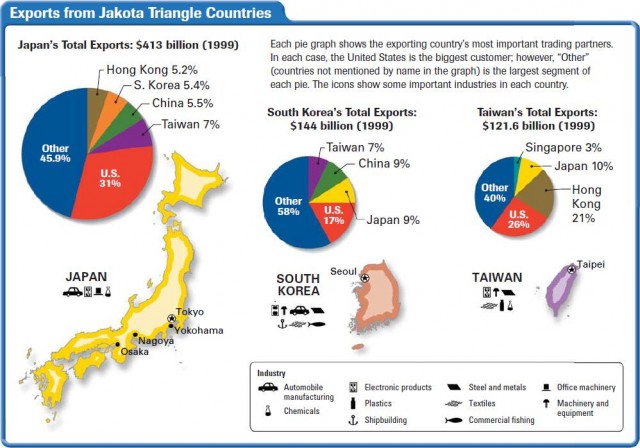East Asia: Trade and Prosperity
A HUMAN PERSPECTIVE At the beginning of the 1990s, the economies of East Asia were growing very rapidly. Unfortunately, there was a dark side to this prosperity. In 1995, UNICEF (the United Nations Children's Fund) reported that more than half a million children in East Asia were working in factories or begging on the streets. UNICEF regional director Daniel Brooks noted that, due to fast-paced economic growth, “We are seeing the erosion of family values and that includes the exploitation of children.” This is one of the important issues facing the region.
Opening Doors
The process by which East Asia became an economic powerhouse took centuries. Until the 1500s, the nations of East Asia had been isolated from the rest of the world. As Western demand for Asian products grew, European traders used a variety of means—including force—to end East Asia's isolation.
Eventually, the economies of the region were to emerge as major players in the global economy. However, foreign intervention and world war lay ahead before East Asian nations achieved widespread prosperity.
OPENING TO THE WEST
By the 1800s, the nations of Europe had signed treaties that gave them distinct spheres of influence in the East. These were areas where they could control trade without interference from other Western nations. In 1853, Commodore Matthew Perry set sail from the United States to Japan to persuade the Japanese to establish trade and diplomatic relations with the United States. The naval warships that accompanied Perry intimidated Japan into opening its doors to the United States and the West.
INDUSTRIALIZATION AND GLOBALIZATION
After World War II, the nations of East Asia began industrializing, using cheap labor to produce goods for trade. Trade between East and West steadily increased. The labels “Made in China” and “Made in Japan” on goods became very common in the United States and Europe.
At the same time, regional economies, which had evolved from national economies, began to merge. Eventually, a global economy developed, in which nations became dependent on each other for goods and services. For example, Japan imported many natural resources from around the world and then transformed those resources into manufactured goods that it sold around the globe. The nations of East Asia used their supplies of cheap labor to become manufacturing powerhouses. The World Bank described this boom as an “economic miracle.”
Powerful Economies of East Asia
During the 1980s and early 1990s, many Asian economies did very well. The most powerful of the Pacific Rim nations of East Asia—Japan, Taiwan, and South Korea—enjoyed record prosperity. These three countries formed a part of a zone of prosperity referred to by some as the Jakota Triangle—Japan, Korea (South), and Taiwan. By the mid-1990s, however, these economies were experiencing problems.

ECONOMIC PROBLEMS ARISE
Although some East Asian economies appeared healthy, they were burdened by debt and mismanagement. The Asian economic miracle had been based in part on efficiency and innovation. It also had been built partly on the sacrifices of very poor and very young workers, who were paid low wages.
In the mid-1990s, a series of banks and other companies went bankrupt (could not pay their debts). This sparked panic among foreign investors, who began selling their Asian stocks and currency. In some countries, riots broke out. In Japan and South Korea, ruling politicians had to resign. Japan's economy entered a recession—an extended decline in general business activity. The Asian economic miracle had come to an end. South Korea and Taiwan also experienced recessions.
A GLOBAL RIPPLE EFFECT
Because the economies of many nations are interconnected, the crisis in Asia spread throughout the world. Uncertainty led to concern at the New York Stock Exchange and other national exchanges. To prevent a global economic downturn, the World Bank and the International Monetary Fund stepped in, lending money to East Asian countries that promised reform. This began to reverse the downslide, but the world had learned an important lesson—a global economy could threaten prosperity as well as improve it.
THE PROMISE OF REFORM
The economic crisis led to an awareness in East Asia that serious reform was necessary. Reform would have to include increased wages for adult workers, as well as a ban on child-labor and forced-labor practices. It would also mean an end to sweatshops. These are workplaces where people work long hours for pennies under poor conditions. At the dawn of the 21st century, reforms had begun, and Asian economies were showing new signs of life.
In the next section, you will read about the expanding population of East Asia. The growth in population has had an impact on the quality of life in the region.